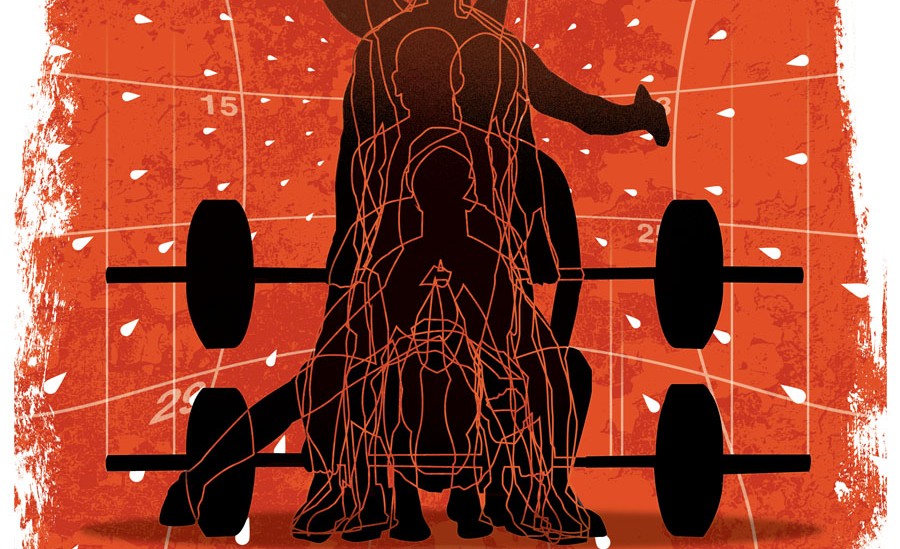CROSSFIT: BADASS
Joining CrossFit has been one of the most toughest challenges of my life—and the most rewarding. I’ve been a member of my local CrossFit box since early July, and I’ve never felt better physically or mentally. CrossFit is a rigorous, all-out regime, but it’s not nearly as fanatical or dangerous as the hype would have you believe.
Before I could start the group classes, I had to undergo multiple sessions to assess my physical fitness. I was also shown the correct posture and range of motion necessary to execute many of the movements and Olympic lifts I would be doing once I advanced. While I was impatient to get started, the assessment was crucial because it highlighted my strengths and weaknesses, showing me where I needed to work the most and helping me avoid injury in those weaker areas. And it’s a great example of how particular CrossFit gyms (for example, both co-owners of CrossFit Asheville, my local box, are chiropractic doctors) are taking good care of their own, despite the reputation of being extreme to the point of risk.
I’ve learned so much about the mechanics of the body and the amazing things it can do. Learning about nutrition for optimized performance has been a critical side benefit of the training, and part of why I love the community-building, information-sharing aspect of the program. CrossFit is also a constantly varied form of strength and conditioning: so refreshing for me and people like me who get easily bored by the conventional gym routine of bench presses and bicep curls. Whether it’s 10 handstand pushups or the 21-15-9 repetitions of thrusters and pull-ups in the “Fran” workout, I’ve never been bored at CrossFit and I’ve always felt the excitement of pushing myself to new heights.
I’ve formed friendships with my CrossFit peers, veterans and newbies alike. It still amazes me how encouraging everyone has been, despite the competitive vibe. Yes, there are members who could quite literally run circles around me and use the weight I find challenging as a warm up. Even so, I’ve never had anyone look down on me. The go hard or go home attitude of CrossFit might be a turn-off to some, but I see it more as a call to action for personal growth.
Nick Piltoff is a freelance photographer and hiker.
CROSSFIT: BAD IDEA
CrossFit is a growing craze in fitness communities across North America, but in this trainer’s opinion, it’s just that: a little bit crazy.
First, let me give credit where credit is due: the basic selection of exercises that most CrossFit gyms make their central hub is excellent. Movements like squats, standing press, deadlifts, olympic lifts, and pull ups are excellent choices for an able-bodied lifter to add to their workout routine to reinforce good motor patterns and lifting technique. If it weren’t for CrossFit, these kinds of exercises wouldn’t be gaining traction to the extent they have been in the general population.
But that’s what worries me. The routines prescribed by CrossFit are challenging even for very active, very experienced athletes. The average Joe or Jane who’s attracted to the undeniably quick results of CrossFit aren’t people who fit this category. Folks like this need more foundational development before being trained to do intense CrossFit workouts which can start to stray from sound technical precision in the name of racing the clock and under the ethos of pushing yourself through and beyond pain. Even those pros I mentioned above can easily get hurt—sometimes grievously—under these conditions.
Unfortunately, these types of workouts dominate CrossFit, where fitness is essentially measured by how fast you can complete a checklist of sorts of weight-training-related work. The effectiveness of doing 50 squats, 60 pull-ups, and 100 kettlebell swings can go down the drain when the element of time enters the picture. Doing any of these movements while extremely fatigued creates a large window for injury, and those who are not already incredibly conditioned could hurt themselves.
And if the very real risk of injury weren’t enough, I also consider the cost of most CrossFit gyms a deterrent—in some places it can be as much as $300 just to join, on top of a $200 monthly fee. Add in the fact that certification as a CrossFit trainer can take as little as two hours, and you’ve got more than enough cons to outweigh the pros.
If you’re looking for one hell of a workout that may yield great cosmetic results, then try CrossFit—but remember that it’s at your own risk. There are other, much safer ways to get the same results and improve your skills at the same time.
Lee Boyce is a fitness writer and strength coach.








